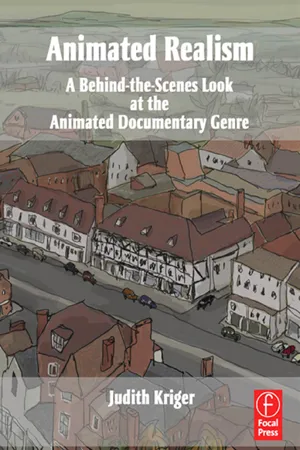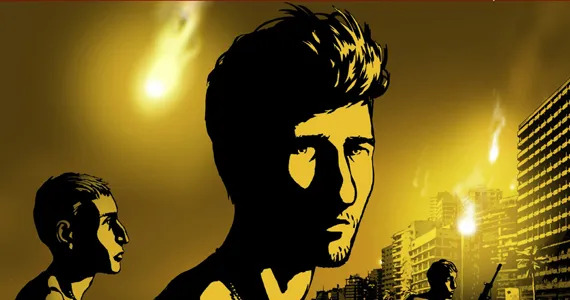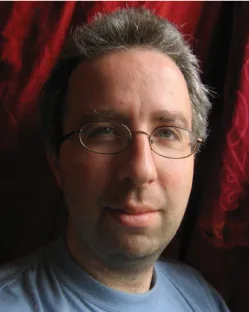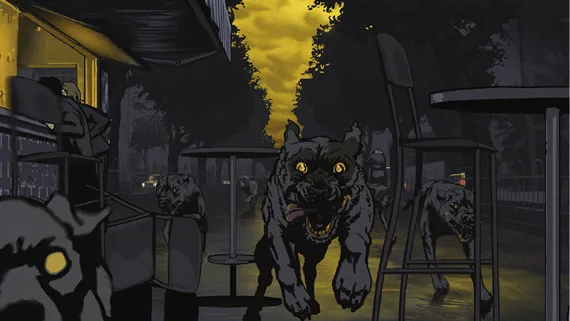![]()
Finding Pleasure in the Imperfection: Yoni Goodman
There’s No School Like the Old School
Documentary films date back many decades. John Grierson, a Scottish documentary filmmaker born in 1898 and considered the father of documentary filmmaking, defined documentary as “the creative treatment of actuality.” While studying in the United States, Grierson concentrated his research on the psychology of propaganda, focusing on how public opinion is formed and influenced by mass media, film, and the press. What a field day Grierson would have had today, with the explosion of reality TV shows, social media networking, the Internet, and 24-hour cable news networks.
FIG 1.1 Yoni Goodman.
Grierson was effectual in developing documentary cinema in both Britain and Canada but clearly didn’t hold the Hollywood entertainment industry in the highest regard. In his 1932 essay, “First Principles of Documentary,” Grierson felt that Hollywood movies didn’t care to show the real world and instead focused on fictional, “artificial” stories. How would he have felt about using animation to tell nonfiction stories? Would the use of digital or hand-drawn “artificial backgrounds” take away from the realism Grierson sought, or would current trends in fusing animation with documentary work believably as “creative treatments of actuality”?
Comic strip artist and animator Winsor McCay’s The Sinking of the Lusitania, copyrighted in 1918, was an animated film depicting the real-life torpedoing of the English Cunard liner Lusitania by a German submarine off the coast of Ireland and can be considered a precursor to today’s animated documentaries. Max Fleischer began working in animation in 1915 and also got his start as a newspaper cartoonist. Together with his brother Dave, they patented the process known as Rotoscope in 1917. Their invention allowed the artist to draw frame-by-frame over live-action footage and is very much responsible for the look development of many of today’s animated documentaries. Fleischer Studios created such memorable characters as Betty Boop and the star of the Out of the Inkwell series, KoKo the Clown.
The inventive influences of McCay and the Fleischer brothers have been carried forward to modern times in the pioneering feature documentary “Waltz With Bashir”. Animation Director Yoni Goodman used a 2D, hand-drawn look to help tell Director Ari Folman’s unforgettable story.
Biography
Born in 1976, Yoni Goodman began his career as an illustrator and designer for Maariv and Haaretz, two major Israeli newspapers. While studying in the Department of Visual Communication at the Bezalel Academy of Art and Design in Jerusalem, Goodman fell in love with animation and hasn’t stopped making it since.
After graduating in 2002, he worked as a freelance animator and illustrator for numerous TV shows and commercials. In 2004, Goodman worked as Director of Animation for Ari Folman’s documentary series, The Material That Love Is Made Of, creating three five-minute animated shorts that were used in the series. Goodman’s successful connection with Ari Folman led to their next collaboration, Waltz with Bashir (2008). Goodman was Director of Animation and developed the Adobe Flash cut-out animation technique needed to create this feature.
Goodman has taught animation in the Bezalel Academy of Arts and Design and lives in Israel with his wife Gaya and their children Anat, Itamar, and Noa. He claims to suffer from a mild addiction to chocolate and coffee, which he says he can quit anytime he wants.
FIG 1.2
Printed with Permission, ©Bridgit Folman Films Gang LTD. 2009.
Interview
Judith Kriger: How did you first get involved with animation?
Yoni Goodman: After my military service, I started working at a newspaper. Afterwards, I went to an art school called Bezalel when I heard they had an animation course there.
JK: Can you describe what the program is like at Bezalel?
YG: When I was there, I studied in visual communications, which meant I was involved with graphic design, illustration. At that time [around 2000], animation was more of a specialized course, not a major. Nowadays, animation at Bezalel is a very developed, structured department, and has won a few prizes. Up until two years ago, I taught Flash, animation, and mentored some of the senior projects there. I had to give up teaching, though, because it became a bit too much with all my other [commercial and feature] jobs.
JK: Who or what influences you?
YG: A lot of things. All sorts of animation. Early Disney work, Milt Kahl’s work, stuff like that. For the next feature, we’re researching the Fleischer Studios’ work. This is probably my favorite animation studio. The art in our next feature is going to be loosely based on the Fleisher cartoons—the “old school” style. They did some amazing stuff in their early cartoons.
JK: What attracts you to their work?
YG: It’s interesting because at that point in time, Disney and Fleischer Studios were pretty much equal. Disney, of course, made Steamboat Willie, and then they went on to make Snow White, and Fleischer Studios eventually collapsed. They made some really wild, crazy animation. It’s interesting—the period when those two studios were at their highest—I think about what animation might have looked like today if the Fleischers had won the “fight,” so to speak. Disney always went for the very emotional cartoons, and the Fleischer cartoons were really hard-core, crazy.
JK: That is an interesting thought; think about how different Pixar would have been today if that had happened.
YG: That’s the ironic thing about Pixar, actually, because they are “dropouts” from Disney. Disney said, “we don’t want you; you’re too wild and crazy,” and now John Lasseter controls all the creative aspects of Disney. I’m sure he’s laughing about it constantly, because you know—they kicked him out. He showed them!
JK: He sure has!
YG: I’m not overly fond of the later Disney work; I like their earlier stuff. Maybe it’s because I’m now trying to get back to the core of animation, get back to where it all began. I’m really studying the early days of animation; all the Winsor McCay work. There’s some amazing stuff there. That’s the difference—in early animation, you can see that the animators were exploring. For example, it’s the difference between The Jungle Book and The Jungle Book 2. Jungle Book, for me, is one of the top five animated films ever. When you look at it closely, you see tons of “mistakes”—not truly mistakes, but what I mean is that you can see that some of the characters are not drawn perfectly anatomically correct, and you can see the roughness of the line. You can also sometimes see the brushstrokes in the backgrounds, and it’s real magic. In Jungle Book 2, everything is so perfect … and so boring! I’m not saying that to criticize Disney animators, because they’re amazing craftsmen—it’s just that it’s a little too “perfect.” I find pleasure in the imperfection, and that’s exactly what I see in the early cartoons.
JK: Yes, it’s similar to watching, for example, Aardman Studios’ work and noticing fingerprints in the clay. This is one of the things that attracted to me to Waltz with Bashir: the story is very personal and so intense, and you’ve made it look like it’s hand-drawn, and you see the imperfection in the line. You can therefore see the human being behind the “camera”—this, to me, is one of the reasons why it works so well.
YG: I’m very pleased with the way the animation turned out. It was like a solution to a problem. It is actually very technical, because we used Flash to make it look like cut-out animation. Doing the animation on Bashir was like solving a riddle.
JK: What are some of the other movies in your Top 5 list?
YG: One of my biggest influences was Joanna Quinn’s Britannia. It’s amazing—I saw it as a kid—it was one of those things when you say, I want to do that for a living! It has the look of rough pencil, and everything is very alive. Another movie that really influenced me is When The Wind Blows, made in the 1980s. The story describes an elderly couple who experience a nuclear holocaust—but they don’t get the blast, they get the radiation. For 90 minutes, you watch them dying in front of you. This movie really showed me the power of animation. I saw this movie as a kid, and I think it actually affected me more than I knew at the time. You can see drawn human figures and really relate to them; you can really feel them. It’s a sad, melancholic movie, but it also has its high points and definitely is worth seeing.
Also on my list … The Incredibles. I’m a big Brad Bird fan. I like all the Pixar movies—except Cars. This was also a big lesson for us on Bashir: it’s not about the animation; it’s about arriving at the story. It’s about making things fit for the story and not making the story fit for the roller-coaster ride. This is one of the main problems with 90% of the CG movies. In almost every CG movie they have these crazy camera movements and everything moves. Pixar’s movies, on the other hand, hardly ever do that. They focus on the story, and if there’s a roller-coaster scene, it serves the story. In general, CG bores me a bit.
JK: What about it bores you?
YG: Of all the forms of animation, I think CG is the toughest—except, maybe, clay animation. Clay animation is hard because it’s very physical and you can make tons of mistakes. You move your elbow the wrong way and your whole day is ruined. But clay has the magic of being of an organic nature, and that goes a long way. But CG is like a blank page, and you have to fill it with everything. Animation is all about fooling the eye—making the eye see what’s not really there. Nothing about it is real, but you make the eye think it’s real. In traditional animation it’s really easy, because the eye is really easily fooled. As an extreme example, South Park, which is really rough, works—the eye is fooled because it accepts the “rules” of that world. It takes a few seconds, but then you accept it for its visual simplicity and focus on the story. They intentionally make it look simple and mechanical so that the story will come through.
On the other extreme … is CG. You model something in CG and it has a mass; the eye picks up the mass. The more you give the eye, the more it demands. This is why I think realistic CG animation will never work. I see all these technological advances, but when you try to get close to reality, that’s when the eye starts to pick up the small details, and it ruins the illusion. In CG productions, in order to achieve a level of believability, you need to have the budget of a major studio like Pixar, Blue Sky, DreamWorks. They are able to get you interested, and you don’t look at the characters just as modeled polygons. The reason is they have tons of money and tons of people working on these; they have budgets of 100 million dollars per feature. I think only about 10% of the potential of CG has been properly explored. Every studio, every animation student wants to be the next Pixar. I recently had an interview with a few guys in Madrid who said: “We’re going to be the next Pixar!” How? You have a budget of 2 million dollars—how will you beat Pixar?
FIG 1.3
Printed with Permission, ©Bridgit Folman Films Gang LTD. 2009.
Do you think they spend it all on coffee and cookies? <laughs> And these are some of the issues we discussed on Bashir—and this is why we chose a completely different look. If we had tried to make something ...




